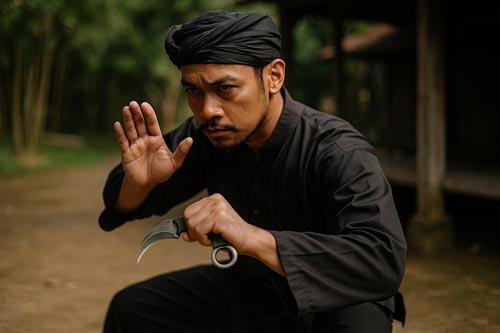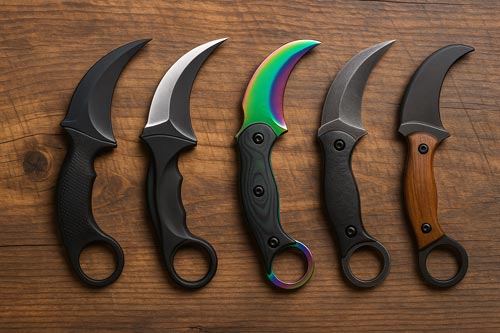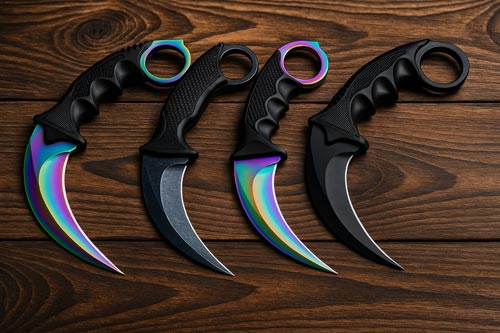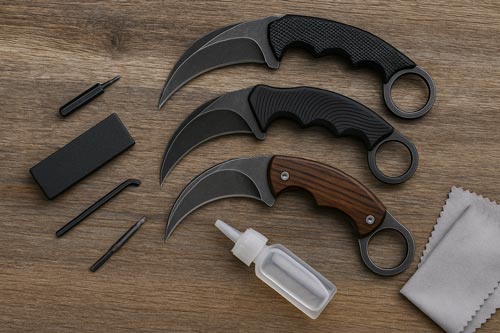The History of the Karambit: From Indonesian Farm Tool to Modern Tactical Icon
October 29th, 2025
Few blades in the world carry a story as unique as the karambit. With its curved, claw-like shape and unmistakable ringed handle, this knife has traveled a long path from the rice fields of Indonesia to the hands of modern martial artists and tactical professionals. The karambit's design is more than just visually striking; it's a product of centuries of evolution, cultural tradition, and practical ingenuity. Whether seen in the dojo, on film, or in a self-defense class, the karambit continues to capture the imagination of those who appreciate tools that balance beauty, history, and purpose.
The Humble Origins of the Karambit

Long before it became a weapon or collectible, the karambit started as a simple tool in the rice fields of Indonesia. Farmers used the curved blade to harvest crops, cut vegetation, and perform delicate agricultural tasks that required both strength and precision. The design was inspired by the claws of big cats native to the region, mimicking their ability to hook, slice, and pull efficiently. That natural motion made the tool incredibly effective for working in tight, repetitive movements without losing control.
Over time, the knife became part of everyday life across rural Indonesia and surrounding Southeast Asian regions. Villagers carried small karambits tucked into their belts or tied to their waists, using them for everything from cleaning fish to crafting tools. The blade's shape and ringed handle were not designed for fighting at first; they were practical choices that helped workers maintain their grip and control while performing physical labor. What began as an essential farming tool would soon evolve into one of the most distinctive fighting knives in the world.
The Karambit's Role in Traditional Martial Arts

As the karambit spread across Indonesia, it evolved from a farmer's tool into a respected weapon within the region's martial arts systems. In the traditional Indonesian art of Pencak Silat, practitioners refined the karambit into a close-combat weapon built for control, precision, and fluid motion. Its curved blade allowed for hooking, trapping, and cutting techniques that mimicked animal movements, while the ringed handle ensured the weapon stayed firmly in hand even during complex transitions.
The karambit became a symbol of skill and mastery. In Silat, it was not seen as a weapon of aggression but as a tool of discipline and defense. Students learned to manipulate the blade in both forward and reverse grips, using small, efficient movements to control opponents rather than relying on brute strength. This training mirrored the values of many Southeast Asian martial arts: balance, awareness, and adaptability.
Other nearby cultures, including Malaysia and the Philippines, incorporated their own variations of the karambit into martial traditions. Filipino Kali and Malaysian Silat each developed techniques that emphasized flow, disarming, and self-protection, showing how the karambit's design fit naturally into the region's fighting philosophies. Even today, modern martial arts schools around the world still teach karambit techniques as part of their advanced weapons training, preserving a legacy that began centuries ago in the Indonesian archipelago.
The Spread of the Karambit Through Southeast Asia

As trade and migration expanded across the Indonesian islands and beyond, the karambit's design began to spread throughout Southeast Asia. Each culture that encountered it adapted the knife to meet its own needs, resulting in a variety of regional styles. In Malaysia, the karambit evolved into the kerambit or korambit, featuring slightly longer blades and decorative handles that reflected local artistry. In the Philippines, the weapon found a natural place within the edged-weapon systems of Kali and Eskrima, where practitioners valued the karambit's ability to maintain control and flow during close combat.
The knife's reputation grew as travelers and traders carried it along maritime routes. Craftsmen began experimenting with different materials, creating versions from bone, wood, and forged steel. The ringed handle became a defining feature that set the karambit apart from other knives of the era. Some designs included multiple rings or ornate patterns engraved along the spine, while others kept a utilitarian simplicity meant for daily work. The weapon's adaptability made it equally useful to farmers, fishermen, and warriors.
Across the region, the karambit earned a place in local identity. In certain Indonesian and Malaysian communities, owning a finely crafted karambit was a sign of honor and skill. In martial practice, it became a weapon passed from teacher to student, symbolizing both heritage and discipline. By the time European explorers arrived in Southeast Asia, the karambit was already deeply rooted in the culture and recognized as one of the most effective and distinctive knives ever created.
The Karambit in Modern Times

Over the past century, the karambit has evolved from a regional tool into an international icon. Its practical design caught the attention of martial artists, military trainers, and knife enthusiasts around the world. As interest in Southeast Asian martial arts spread globally, so did the karambit's reputation for precision and control. Modern instructors began incorporating karambit techniques into tactical training programs, adapting ancient Silat principles to modern combat and self-defense contexts.
The design itself has also changed to meet new needs. Traditional fixed-blade karambits are still favored by purists and martial artists who appreciate their strength and simplicity, but folding karambits have become popular for everyday carry. Manufacturers introduced locking mechanisms, pocket clips, and assisted-opening systems that make these knives easier to carry while preserving the signature curve and ringed grip that define the karambit. Collectors have embraced modern interpretations made from high-grade stainless steel, titanium, and carbon fiber, turning the knife into both a tool and a work of art.
Popular culture has played a big role in the karambit's resurgence. Movies, video games, and social media have introduced new audiences to the weapon's distinctive shape and fast handling. In particular, video games featuring realistic knife models have made the karambit instantly recognizable to millions of players worldwide. That visibility has driven a wave of interest among collectors and martial artists who want to experience the real thing. While the modern karambit now comes in many forms, from functional trainers to decorative showpieces, the core principles of its design remain unchanged: efficiency, control, and unmistakable style.
Why the Karambit Remains Iconic

The karambit stands out because it combines practicality, artistry, and cultural heritage in one design. Its curved blade, ergonomic handle, and retention ring work together to create a tool that is as functional as it is distinctive. Every detail serves a purpose, from the way the blade follows the motion of the hand to the secure grip that allows precise control even in high-stress situations. This balance of form and function is what keeps the karambit relevant centuries after its creation.
Martial artists continue to train with the karambit because of its versatility and control. The weapon rewards technique over strength, allowing practitioners to focus on precision and timing. Instructors teach it as both a defensive and offensive tool, showing how small, calculated movements can redirect force and create openings. For collectors and enthusiasts, the karambit represents craftsmanship and tradition, a tangible link between past and present that highlights the ingenuity of Southeast Asian culture.
In modern times, the karambit has also become a favorite among knife designers and manufacturers who appreciate its engineering potential. From high-end custom pieces to practical everyday models, the karambit's design inspires innovation across the knife industry. Whether you view it as a weapon, a training tool, or a collectible work of art, the karambit's legacy continues to grow as new generations discover its unique combination of history and performance.
If you want to experience the handling and precision of this legendary design for yourself, explore our selection of karambit knives available at KarateMart. Each one captures the same spirit of balance, beauty, and control that has defined the karambit for hundreds of years.
Where Did the Karambit Originate?
The karambit originated in Indonesia, specifically on the island of Sumatra, where it was first used by farmers and villagers as a practical cutting tool. Its design was influenced by the natural world, with the curved blade modeled after a tiger's claw. This shape allowed users to harvest crops, slice through vegetation, and complete daily tasks with ease and precision.
As the design proved effective, it spread across nearby islands and into neighboring countries like Malaysia and the Philippines. Each region adapted the karambit to its own needs, using different materials and handle styles while maintaining the iconic curved blade and ringed handle. Over time, the karambit became an important cultural symbol throughout Southeast Asia, representing both craftsmanship and resourcefulness.
What Was the Karambit Originally Used For?
The karambit was originally a farming and utility tool used by Indonesian villagers for daily work. Its curved blade made it perfect for cutting crops, harvesting rice, trimming plants, and clearing brush. The hooked shape allowed farmers to pull and slice in a single motion, increasing efficiency while reducing strain on the hands and wrists.
Over time, the karambit's usefulness extended beyond agriculture. Fishermen used it for cleaning nets and cutting rope, while craftsmen relied on it for shaping materials. The addition of a small ring at the end of the handle made it easier to keep control of the knife, even when working in wet or slippery conditions. Long before it became known as a weapon, the karambit was valued for its practicality and reliability in everyday life.
When Did the Karambit Become a Martial Arts Weapon?
The karambit began its transformation from a farming tool to a martial arts weapon during the early development of the Indonesian martial art known as Pencak Silat. Warriors and villagers discovered that the same features that made the knife useful in the fields, such as its curved blade, secure grip, and excellent control, also made it effective in close combat. Over time, the karambit was refined and incorporated into Silat's weapon training systems as a specialized defensive tool.
In Silat, the karambit became known for its ability to hook, trap, and cut with precision. Practitioners trained to use the ringed handle for quick transitions between forward and reverse grips, allowing them to control the blade without losing their hold during movement. As the weapon spread through Southeast Asia, it took on new forms in local fighting styles, becoming an essential part of traditional martial training that still exists today.
What Makes the Karambit's Design So Unique?
The karambit's design stands out because every feature serves a specific purpose. The curved blade mirrors the natural shape of a claw, allowing for powerful slicing and hooking motions that require very little force. This makes the karambit incredibly efficient at cutting while maintaining control, even in close-range situations. The inward curve also helps keep the blade in contact with the target during a pulling motion, increasing precision and reducing the risk of slipping.
Another key feature is the ring at the end of the handle. Originally added for grip security during farm work, it later became a defining part of the weapon's identity. The ring allows users to spin or rotate the knife smoothly between grips and ensures it stays firmly in hand during fast movements. Combined with an ergonomic handle that fits naturally into the palm, the karambit's design offers both comfort and control. Whether used in martial arts, collection, or practical applications, its shape remains one of the most distinctive and functional in knife history.
You May Also Be Interested In:
- The Real History of Nunchaku: From Farm Tool to Martial Arts Icon
- The Evolution of the Bowie Knife: From Frontier Tool to Collectible Icon
- From Jungle Tool to Movie Legend: The History of the Machete
- History of the Baton: From Police Nightstick to Self-Defense Tool
- Brass Knuckles Explained: History, Design, and Modern Laws
- The History of the Kendo Uniform: From Samurai Armor to Modern Training
- Modern Tactical Khopesh and Other Deadly Weapons
- Modern Tactical Kopis Sword and Other Dangerous Weapons! ☠️
- Unique Weapons Put to the Test: From Mall Ninja to Modern Tactical!
- Top 5 Affordable Karambit Knives
Leave a Reply
























